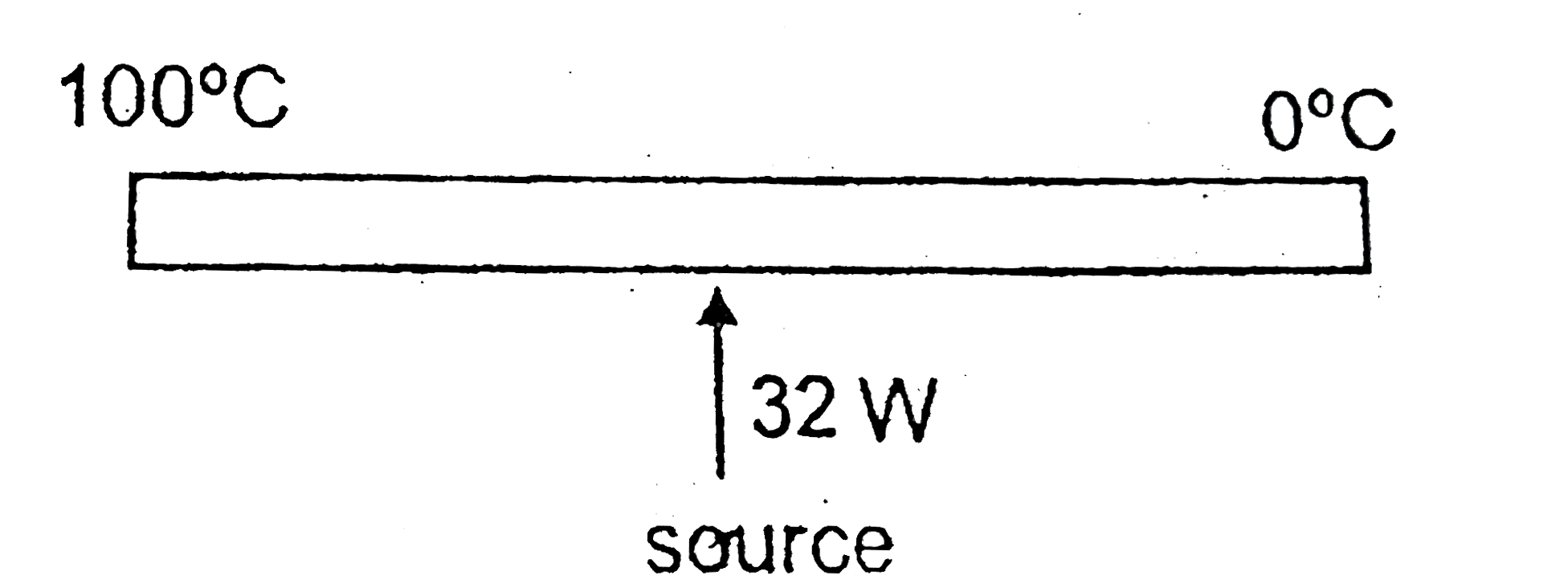The ends Q and R of two thin wires, PQ and RS, are soldered (joined) together. Initially each of the of wire has a length of 1m at 10∘C. Now the end P is maintained at 10∘C, while the ends S is heated and maintained at 400∘C. The system is thermally insultated from its surroundings. If the thermal conductivity of wire PQ is twice that of the wire RS and the coefficient of linear thermal expansion of PQ is 1.2×10−5K−1, the change in length of the wire PQ is
0.78mm
0.90mm
1.56mm
2.34mm
The correct Answer is:A
To solve the problem, we need to determine the change in length of wire PQ when one end is kept at 10°C and the other end is connected to wire RS, which is heated to 400°C.
1. Understanding the Setup:
- We have two wires: PQ and RS, each initially 1 meter long at 10°C.
- End P of wire PQ is kept at 10°C, and end S of wire RS is heated to 400°C.
- The thermal conductivity of wire PQ (K1) is twice that of wire RS (K2): K1=2K2.
- The coefficient of linear thermal expansion (α) for wire PQ is given as 1.2×10−5K−1.
2. Finding the Junction Temperature (T):
- The rate of heat flow through both wires must be equal since they are in thermal contact:
K2A(400−T)L=K1A(T−10)L
- Canceling A and L from both sides, we get:
K2(400−T)=K1(T−10)
- Substituting K1=2K2:
K2(400−T)=2K2(T−10)
- Dividing through by K2 (assuming K2≠0):
400−T=2(T−10)
- Simplifying this equation:
400−T=2T−20
400+20=3T
T=4203=140°C
3. Calculating the Change in Length of Wire PQ:
- The temperature difference for wire PQ is 140−10=130°C.
- The change in length ΔL due to thermal expansion is given by:
ΔL=L⋅α⋅ΔT
- Substituting the values:
ΔL=1⋅(1.2×10−5)⋅130
- Calculating the change in length:
ΔL=1.2×130×10−5=156×10−5m=1.56×10−3m=0.156mm
4. Final Result:
- The change in length of wire PQ is approximately 0.156mm.
- We have two wires: PQ and RS, each initially 1 meter long at 10°C.
- End P of wire PQ is kept at 10°C, and end S of wire RS is heated to 400°C.
- The thermal conductivity of wire PQ (K1) is twice that of wire RS (K2): K1=2K2.
- The coefficient of linear thermal expansion (α) for wire PQ is given as 1.2×10−5K−1.
- The rate of heat flow through both wires must be equal since they are in thermal contact:
K2A(400−T)L=K1A(T−10)L
- Canceling A and L from both sides, we get:
K2(400−T)=K1(T−10)
- Substituting K1=2K2:
K2(400−T)=2K2(T−10)
- Dividing through by K2 (assuming K2≠0):
400−T=2(T−10)
- Simplifying this equation:
400−T=2T−20
400+20=3T
T=4203=140°C
- The temperature difference for wire PQ is 140−10=130°C.
- The change in length ΔL due to thermal expansion is given by:
ΔL=L⋅α⋅ΔT
- Substituting the values:
ΔL=1⋅(1.2×10−5)⋅130
- Calculating the change in length:
ΔL=1.2×130×10−5=156×10−5m=1.56×10−3m=0.156mm
- The change in length of wire PQ is approximately 0.156mm.
Topper's Solved these Questions
- BOOK - ALLENCHAPTER - GEOMETRICAL OPTICSEXERCISE - EXERCISE - 05 (B) (MCQ)9videos
GEOMETRICAL OPTICS
- BOOK - ALLENCHAPTER - GEOMETRICAL OPTICSEXERCISE - EXERCISE - 05 (B) (MATCH THE COLUMN)3videos
GEOMETRICAL OPTICS
- BOOK - ALLENCHAPTER - GEOMETRICAL OPTICSEXERCISE - EXERCISE - 05 (A)73videos
GEOMETRICAL OPTICS
- BOOK - ALLENCHAPTER - CURRENT ELECTRICITYEXERCISE - EX.II66videos
CURRENT ELECTRICITY
- BOOK - ALLENCHAPTER - GRAVITATIONEXERCISE - EXERCISE 49videos
GRAVITATION
Similar Questions
A wire of length 5m is twisted through 300 at free end If the radius of wire is 1mm , the shearing strain in the wire is
View SolutionA rod AB is 1m long. The temperature of its one end A is maintained at 100∘C and other end B at 10∘C, the temperature at a distance of 60 cm from point B is
View SolutionThe ends of a metre stick are maintain at 100∘C and 0∘C . One end of a rod is maintained 25∘C . Where should its other end be touched on the metre stick so that there is no heat current in the rod in steady state?
View Solution
A current of 10A exists in the circuit figure.The wire PQ has a lengths of 100cm and the magnetic field in which it is immersed has a magnitude of 0.20T.Find the magnetic force acting on the wire PQ.View SolutionOne face of an aluminium cube of edge 2 metre is maintained at 100∘C and the other end is maintained at 0∘C. All other surfaces are covered by adiabatic walls. Find the amount of heat flowing of heat thorugh the cube in 5 seconds. (thermal conductivity of aliminium is 209W/m−.∘C)
View SolutionThe pressure that has to be applied to the ends of a steel wire of length 10cm to keep its length constant when its temperature is raised by 100∘C is : (For steel Young's modulus is 2×1011Nm−2 and coefficient of thermal expansion is 1.1×10−5K_1)
View SolutionThe ends of copper rod of length 1m and area of cross section 1cm2 are maintained at 0∘C and 100∘C. At the centre of rod, there is a source of heat of 32W. The thermal conductivity of copper is 400W/mK
 View Solution
View SolutionThree identical metal rods A, B and C are placed end to end and a temperature difference is maintained between the free ends of A and C. If the thermal conductivity of B(KB) is thrice that of C(KC) and half that of A(KA), (KA=49w/mK) calculate the effective thermal conductivity of the system ?
View SolutionOne end of a wire of length L and weight w is attached rigidly to a point in roof and a weight w1 is suspended from its lower end. If A is the area of cross-section of the wire then the stress in the wire at a height 3L4 from its lower end is
View SolutionA body of mass M is attached to the lower end of a metal wire, whose upper end is fixed . The elongation of the wire is l.
View Solution
